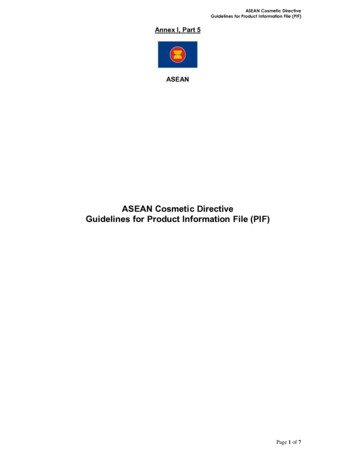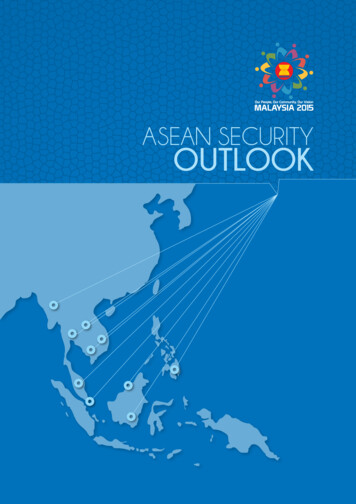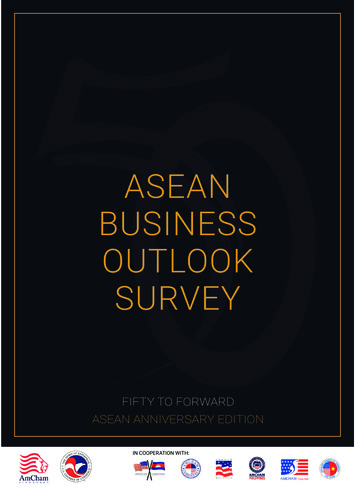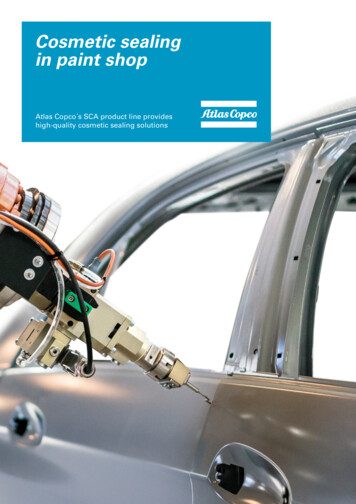
Transcription
ASEAN Cosmetic DirectiveGuidelines for Product Information File (PIF)Annex I, Part 5ASEANASEAN Cosmetic DirectiveGuidelines for Product Information File (PIF)Page 1 of 7
ASEAN Cosmetic DirectiveGuidelines for Product Information File (PIF)Table of Content1.2.Introduction and Objective . 3PIF Organization . 32.1 Product Information Required under ACD . 32.2 Recommended PIF format . 3Part I: Administrative Documents and Product Summary . 4Part II: Quality Data of Raw Materials . 4Part III: Quality Data of Finished Product. 5Part IV: Safety and Efficacy Data . 53. Who is responsible to keep the PIF . 64. PIF Audits. 64.1 Types of audits: . 64.2 Documents to be made readily available: . 64.3 Documents to be made accessible to Authori ties within reasonable time: . 64.4 Background or supplementary documents:. 74.5 Document media: . 7Page 2 of 7
ASEAN Cosmetic DirectiveGuidelines for Product Information File (PIF)1. Introduction and ObjectiveThe ASEAN Cosmetic Directive (ACD) requires persons or companies placing a product onthe market to keep a product information file “readily accessible to the regulatory authority ofthe Member State concerned at the address specified on the label in accordance with article6 of this Directive”.The main objective of this ASEAN Product Information File (PIF) Guideline* is to providecompanies placing a cosmetic product in the market recommendations on how to organizeand compile the PIF based on a recommended PIF format. This document also providesguidance on who is responsible to keep the PIF and some guiding points for PIF audits.*This Guideline is not a legal document and as such, compliance is not a mandatoryrequirement.2. PIF Organization2.1 Product Information Required under ACDArticle 8 of the ACD spells out the list of information required in the PIF:a) The qualitative and quantitative composition of the product, in case of perfumecompositions, the name and code number of the composition and the identity of thesupplier;b) Specifications of the raw materials and finished product;c) The method of manufacture complying with the good manufacturing practice as laiddown in the ASEAN Guidelinesd) Assessment of the safety for human health of the finished product, its ingredients,their chemical structure and level of exposure;e) Existing data on undesirable effects on human health resulting from use of thecosmetic product; andf) Supporting data for claimed benefits of cosmetic products should be made available;to justify the nature of its effect;Article 9 of the ACD requires the company to provide information on the method of analysisto the regulatory authority:a) The available methods used by the manufacturer to check the ingredients ofcosmetic products corresponding with the Certificate of Analysis; andb) The criteria used for microbiological control of cosmetic products and chemical purityof ingredients of cosmetic products and/or methods for checking compliance withthose criteria”2.2 Recommended PIF formatIn view of the above ACD requirements, companies placing products in the market need toorganize the PIF in such a way that it meets the requirements and be easily consulted by theAuthorities. It is recommended that the PIF be organised into 4 parts as follows:Part I :Part II :Part III :Part IV :Administrative Documents and Product SummaryQuality Data of Raw MaterialQuality Data of Finished ProductSafety and Efficacy DataPage 3 of 7
ASEAN Cosmetic DirectiveGuidelines for Product Information File (PIF)A Table of Contents should be provided for each of the 4 part s.Part I: Administrative Documents and Product SummaryThe first part of the PIF contains the administrative documents and key summary informationthat are specific to a single product; i.e. this part would provide an ample overview of thefinished produ ct.A. Administrative documentation- Copy of the Notification form bearing the acknowledgement receipt from theAuthorities; this will include the identity of the product, the address of themanufacturer, assembler, importer and company placing the product in themarket;- Authorisation letter by product owner or agreement letter related to the product, ifrequired by the legislation of the Membe r Country;- Any other relevant administrative documents that may be prescribed by the localAuthorities e.g. Licence to Operate, Certificate of Incorporation of the Company;B. Qualitative and Quantitative formula of the product (INCI or other ACD approvedreference names and corresponding concentrations of the ingredients):- For fragrance materials, name and code number of the composition and theidentity of the supplier;C. Product presentation and label, including:- Outer and inner labels (photograph s and/or drawings will be useful);- Consumer information leaflets and instruction for use if part of the product as soldto the consumer;D. Manufacturing Statement:- A statement by the manufacturer or company that the product was manufacturedaccording to the ASEAN GMP Guidelines or any ACC approved equivalent GMPGuidelines;- Provide the batch coding system/ key of the product;E. Safety Assessment (summary) as per the ASEAN Guidelines for the Safety Assessmentof a Cosmetic Product:- Safety statement (signed statement of opinion, including the name andqualifications of the safety assessor);F. Confirmed undesirable effects on human heal th (summary);G. On-pack product claim support (summary):- Summary report of the Efficacy Assessment of the product, based on itscomposition or on tests performed;Part II: Quality Data of Raw MaterialsThe second part of the PIF should include full technical information on the quality of the rawmaterials/ ingredients:A. Specifications and test methods of raw material/ ingredients:- Specifications of each ingredient including water specification, if appropriate;- Method of analysis corresponding to the specifications for each ingredient,including identification of the ingredients;Page 4 of 7
ASEAN Cosmetic DirectiveGuidelines for Product Information File (PIF)-For fragrance materials, specify the name and code number of the fragrance,name and address of the supplier, declaration of compliance with the latest IFRAguidelines;B. Data on the safety of the raw materials based on data from the supplier, on publisheddata or on reports from Scientific Committees like the ASEAN Cosmetic Scientific Body(ACSB), the EU Scientific Committee on Consumer Products (SCCP) or the USCosmetic Ingredient Review Board (CIR);Part III: Quality Data of Finished ProductThe third part of the PIF supplies the detailed technical information on the quality of thefinished produ ct:A. Qualitative and Quantitative formula of the product (INCI or other approved ACDreference names and corresponding concentrations of the ingredients):- The formula should specify the functions of each raw material/ ingredient;B. Manufacturing:- Manufacturer contact details: name, country and address of manufacturer,assembler and packager;- Summary of the Manufacturing Process;- Additional detailed information on the manufacturing process, quality controls andrelated manufacturing documents should be made available upon request by theAuthority;C. Specifications and test methods of the finished product:- The criteria used for microbiological control of cosmetic products and chemicalpurity of ingredients of cosmetic products;- Method of Analysis corresponding to the specifications for checking compliance;D. Product Stability Summary Re port, for product durability below 30 months:- The stability testing data and report or stability assessment to support the expirydate;Part IV: Safety and Efficacy DataThe fourth and final part of the PIF provides detailed information on the safety assessmentand data of the finished product and also relevant efficacy data to support any claims madeon the product.A. Safety Assessment:- Signed assessment report of the safety for human health of the finished productbased on its ingredients, their chemical structure and level of exposure;- Curriculum Vitae of the safety assessor;B. The latest compiled report on confirmed or recorded adverse events or undesirableeffects on human health resulting from use of the cosmetic product:- The adverse event report in the PIF is expected to be updated by the companyon a regular basis;C. On-pack product claim support:- Full signed report of the Efficacy Assessment of the product, based on itscomposition or on tests performed;- Supporting data including literature review for claimed benefits of cosmeticproducts should be made available to justify the nature of its effect;Page 5 of 7
ASEAN Cosmetic DirectiveGuidelines for Product Information File (PIF)3. Who is responsible to keep the PIFArticle 8 of the ACD states that the company or person responsible for placing the cosmeticproduct in the market shall keep the PIF readily accessible to the regulatory authority at theaddress specified on the label, which, according to the labelling requirements [Appendix II, C(e)] is “the name and address of the company or person placing the product on the localmarket”. The definition of such has been given in the “Guidance document on productnotification to the Regulatory Authority” as “the local company responsible for placing thecosmetic product in the market, which may be a local manufacturer or an agent appointed bya manufacturer to market the product or the company that is responsible for bringing in theproduct for sale in the country, etc.” This clearly refers to a company or person having anaddress in the local market, and to the company or person responsible for bringing in theproduct into that market; whether this is an importer, a manufacturer or a distributor.It is recommended that the PIF is kept for a minimum period of 3 years after the product islast placed in the market.4. PIF Audits4.1 Types of audits:Since the PIF must be at the address specified on the label, Authorities can audit the PIF atthat address. There are 2 possibilities:·Routine audits: The Authorities will announce these audits in advance. It isrecommended that the audit be announced sufficiently in advance (i.e. at least 1month) for the company to prepare for the audit;·Ad-hoc audits: these may be triggered by results found on s amples from the market,by consumer complaints, etc. It is recommended that the audit be announ ced at least48 hours in advance. In case of extreme urgency the auditing can take place withoutannouncement;4.2 Documents to be made readily available:While the whole PIF should be available, in order to facilitate the preparation of the industry,in particular the SMEs as well as the importers/ distributors, the documents in Part I of thePIF should be made readily available especially for initial investigative audits.4.3 Documents to be made accessible to Authorities within reasonable time:Upon specific request from the Authorities, documents, detailed information or reports inother parts of the PIF should be available and made accessible to the Authorities within anagreed upon timeframe: within 15 to 60 calendar days or shorter, depending on the urgencyof the audit.Page 6 of 7
ASEAN Cosmetic DirectiveGuidelines for Product Information File (PIF)4.4 Proprietary Information:Noting that due to trade secrets, the product owner may not disclose some of the productinformation in any part of the PIF, to the distributor/importer, the person or company placingthe product in the market will need to make their own arrangements with the product ownerto provide the relevant and necessary information directly to the Authorities upon reques t.4.5 Background or supplementary documents:In general the information provided in the PIF should be sufficient for review to ensure “thesafety, quality and claimed benefits of all cosmetic products marketed in ASEAN” asspecified in article 1(a) of the ASEAN Harmonized Cosmetic Regulatory Scheme.However, in some specific cases, other background or supplementary information supportingthe PIF documents (e.g. product experience, microbiological challenge tests, additionalconfirmatory test methods, production records, etc.) may be necessary. The company orperson responsible for placing the product in the market should then make all efforts toprovide the requested information to the Authori ties.4.6 Document media:There are no specific requirements on what media type the PIF documents should bepresented. Hence the company may choose any suitable media i.e. paper, electronic, etc.provided they are convenient and could be easily consulted by the Authorities.Page 7 of 7
D. Product Stability Summary Report, for product durability below 30 months: The stability testing data and report or stability assessment to support the expiry date; Part IV: Safety and Efficacy Data The fourth and final part of the PIF provides detailed information on the safety assessment











